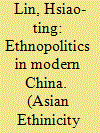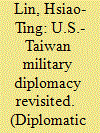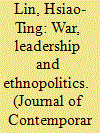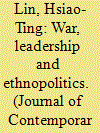|
|
|
Sort Order |
|
|
|
Items / Page
|
|
|
|
|
|
|
| Srl | Item |
| 1 |
ID:
097809


|
|
|
|
|
| Publication |
2010.
|
| Summary/Abstract |
This article reveals the murky political landscape of Alashaa Banner in Inner Mongolia during the Sino-Japanese war (1937-1945). By using various archival documents and secondary source materials, this research seeks to present a clearer picture of Inner Mongolian borderlands, involving the Chinese Nationalists, the Sinicized Muslims, and the Inner Mongols. Instead of restating the 'ineffectiveness' or 'weakness' of the Nationalist frontier administration in China's innermost borderlands during the pre-1949 decades, this article attempts to explore the extent of the war-threatened Nationalist Chinese effort to initiate their state-building tasks and promote their regime's power consolidation in modern China's northern periphery.
|
|
|
|
|
|
|
|
|
|
|
|
|
|
|
|
| 2 |
ID:
102349


|
|
|
|
|
| Publication |
London, Routledge, 2011.
|
| Description |
xxx, 192p.
|
| Standard Number |
9780415582643, hbk
|
|
|
|
|
|
|
|
|
|
|
|
Copies: C:1/I:0,R:0,Q:0
Circulation
| Accession# | Call# | Current Location | Status | Policy | Location |
| 055787 | 305.8009516/LIN 055787 | Main | On Shelf | General | |
|
|
|
|
| 3 |
ID:
126719


|
|
|
|
|
| Publication |
2013.
|
| Summary/Abstract |
This article seeks to retrace the making of the 1954 U.S.-Taiwan military alliance and shed new light on the Taiwanese perception of the issue. As will be revealed, the conclusion of the 1954 defense treaty between Washington and Taipei was not only a result of the American Cold War strategy in the Far East, as the numerous existing historical literature have admirably depicted. It was also a representation of Chiang Kai-shek's sophisticated military diplomacy, involving the role of a hitherto little-known group of Japanese then serving as his "unofficial" advisors. New historical evidence also suggests that, in this military diplomacy, Chiang played with the United States, for signing a defense pact was originally not one of his priorities. Rather, what Chiang had initially sought from America was the means by which to rearm his forces so as to strengthen his position to launch a military recovery of the mainland.
|
|
|
|
|
|
|
|
|
|
|
|
|
|
|
|
| 4 |
ID:
086305


|
|
|
|
|
| Publication |
2009.
|
| Summary/Abstract |
This article examines how China's war with Japan served as a crucial factor that shaped modern China's ethnopolitics. It argues that the Japanese invasion of China in 1941-1945 provided the Nationalists with an unprecedented opportunity to push their authority further westward into the Central Asian heartlands. The Nationalists' marching westward as a result of the Japanese invasion also urged them to factor frontier and ethnopolitics into their wartime strategic thinking and institutional reforms. To a great extent, the war and its repercussions caused a redefinition of modern China's border security and defense in both northwestern and southwestern China. The war with Japan turned the Nationalists westward, a new perspective which shifted the power relationship between the Nationalists and China's frontier regional leaders. This historical phenomenon resulted in the extension of Nationalist power to, and the building of, new institutions and infrastructures, in China's remotest ethnic frontier. It also contributed to modern China's first contact with the Middle East. The westward expansion during wartime also transformed modern China from a maritime economy rooted in East Asian trade to a continental one based on overland trade routes through the heartland of Asia.
|
|
|
|
|
|
|
|
|
|
|
|
|
|
|
|
| 5 |
ID:
086322


|
|
|
|
|
| Publication |
2009.
|
| Summary/Abstract |
This article examines how China's war with Japan served as a crucial factor that shaped modern China's ethnopolitics. It argues that the Japanese invasion of China in 1941-1945 provided the Nationalists with an unprecedented opportunity to push their authority further westward into the Central Asian heartlands. The Nationalists' marching westward as a result of the Japanese invasion also urged them to factor frontier and ethnopolitics into their wartime strategic thinking and institutional reforms. To a great extent, the war and its repercussions caused a redefinition of modern China's border security and defense in both northwestern and southwestern China. The war with Japan turned the Nationalists westward, a new perspective which shifted the power relationship between the Nationalists and China's frontier regional leaders. This historical phenomenon resulted in the extension of Nationalist power to, and the building of, new institutions and infrastructures, in China's remotest ethnic frontier. It also contributed to modern China's first contact with the Middle East. The westward expansion during wartime also transformed modern China from a maritime economy rooted in East Asian trade to a continental one based on overland trade routes through the heartland of Asia.
|
|
|
|
|
|
|
|
|
|
|
|
|
|
|
|
|
|
|
|
|